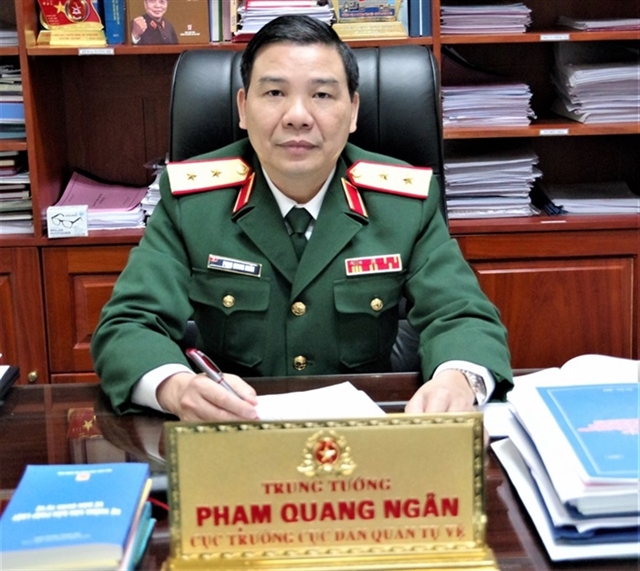 Opinion
Opinion

 |
| Lieutenant General Phạm Quang Ngân, head of the Militia and Self-Defence Force Department. — Photo mic.gov.vn |
On the 89th Traditional Day of the Việt Nam Militia and Self-Defence Force, Lieutenant General Phạm Quang Ngân, head of the Militia and Self-Defence Force Department under the General Staff of the Việt Nam People's Army, spoke with the Quân Đội Nhân Dân (People's Army) newspaper about the development and notable achievements of the militia and self-defence force.
For almost nine decades of building, combat and growth, the Militia and Self-Defence Force (MSDF) has been pivotal in battles, labour and various activities. How has the force developed and upheld its traditions?
MSDF represent 1.4 per cent of the population, with more than a quarter of its officers being Party members. These dedicated individuals receive rigorous military, political and legal training, operating within a tightly-knit organisational structure.
Beyond defence, the MSDF serves as a front-line force in disaster response and community support, conducting search and rescue missions.
Since 2002, nearly 40 million MSDF members, along with hundreds of coastal militia vessels, have engaged in combat readiness exercises and border defence to protect national sovereignty and aid in disaster relief.
Their efforts are crucial in upholding political security and social order, and fostering local economic growth.
During the COVID-19 pandemic, over 890,000 MSDF members contributed over 2.2 million man-days to combat the outbreak, earning praise from Party leaders and the public alike.
What factors have contributed to achieving these results?
In the ongoing effort to fortify and safeguard the nation, the Party and State have consistently prioritised guiding and bolstering the MSDF, enhancing their overall quality and readiness. The 14th National Assembly responded to evolving needs by amending the MSDF Law, effective since July 1, 2020, charting a path for robust expansion and continuous improvement of the MSDF's capabilities.
Diverse MSDF models have emerged, including integrated checkpoints in residential areas and border posts, alongside provincial-level units and defence units within enterprises, efficiently replicated across regions.
Emphasis is placed on training and empowering local defence officers and MSDF personnel, with military agencies at all levels assuming an increasingly crucial advisory role. This approach drives innovation in training, exercises and operations, blending political and legal education to maximise effectiveness.
Despite regulatory challenges, the MSDF has garnered attention and support from various entities, bolstering their confidence in executing duties. Future amendments to Decree 72/2020/NĐ-CP will further optimise MSDF operations, enhancing their quality and effectiveness in dynamic circumstances.
The coastal militia and self-defence force project made significant progress in 2023, establishing new units to protect our seas and islands. Looking ahead to 2024, what are the key objectives for the force?
The focus in 2024 for the Militia and Self-Defence Force Department is on advising and implementing initiatives to elevate MSDF operations. We will execute projects outlined by the Central Military Commission and Defence Minister to strengthen and expand the force, ensuring optimal numbers, composition and organisation.
Our efforts will include training village-level MSDF leaders and grassroots military officers, enhancing their skills through improved training, competitions and sports events. Combat readiness exercises will be central to our activities.
We aim to further develop, expand MSDF units, fortify border posts, establish local MSDF headquarters and enhance military unit committees at village levels.
In 2024, we'll engage in ship competitions, national defence sports, civilian and MSDF shooting contests, and workshops to enhance skills for rural development, defence and the force's operations.
Looking ahead to further strengthen and expand the MSDF to meet the challenges of the new era, what steps must we take next?
To strengthen and expand the MSDF for the challenges ahead, key efforts include enhancing leadership from Party committees, local authorities and organisational heads, utilising the full political strength of the system and its people. We'll leverage local military units, village MSDF committees, and unit committees to advise and support higher authorities in guiding the force's operations.
Our aim is to develop a resilient MSDF, focusing on bolstering its political foundation and excelling in all tasks, with special emphasis on Party development in key areas and units, including those with significant responsibilities and foreign investment.
We'll also prioritise improving training quality and operational capabilities for the force, emphasising timely information handling and security at the local level. Good policies and regulations are vital for boosting confidence and commitment among MSDF members.
Effective propaganda, dissemination and legal education will raise awareness and responsibility among officials and Party members, particularly those leading MSDF operations. Building a strong and extensive MSDF is a strategic imperative that must be pursued during peacetime to meet future defence challenges proactively. — VNS




